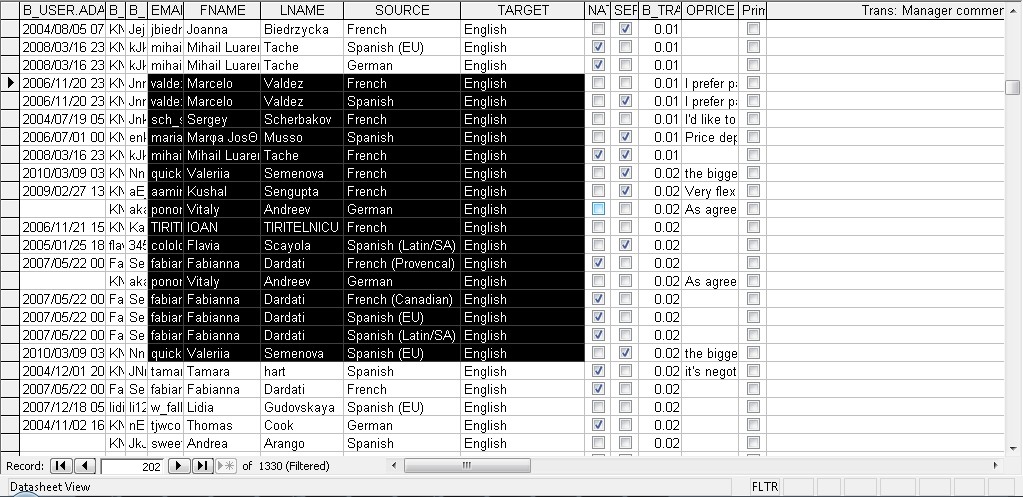 to see something like this:
to see something like this:
Now that you have thousands of translators in your database, perhaps including the more than 12,000 you have purchased of our own [ , or you have been using our quick and easy-to-fill online application form to pick up many more, how can you choose and approach a select number for a very large project? Or to find a select few ideal for a very specific project? Easy!
Remember our Translator table and what it looks like from the perspective of the translator when they fill in the online application form [ .
Let's start with a simple example, as if you have picked up a massive project [add the latest] (I once single-handedly managed a 5 million word project from eleven languages which needed to be translated within one month! Hundreds of translators were required and which inspired me to develop this software) and need as many French, German and Spanish into English translators as possible.
We'll start by going to the Language Query form. As
explained in the search features [treeplanting] , in any datasheet just press
the Filter by Form button  to see something like this:
to see something like this:

Note that I already filled in the first search criteria: Source Language is "Like 'span*'" and Target Language is "English". I put a star (*) after "span" since a star in database speak means "any number of any characters". Putting such a search criteria would therefore include translators who can translate either from Spanish (Latin America) or Spanish (Europe). You can break down each language as much as you like, while in this simple manner you include all variations during a search.
At the bottom of this window you will find:

which is used to expand your search criteria (hence the "or"). To those tabs I added both German to English and French* to English (to include French Canadian, French Creole and French European etc. – we are translating into English, remember? No need to limit ourselves by the source language specification).
On each tab we could specify further by asking only for those translators who claim they are experts in a particular subject, or below a certain price, but I will keep things simple for this example.
Now we press the Apply Filter button  to yield the following results:
to yield the following results:

For the purposes of this simple example I have sorted the results (1,330 out of 17,900+ total - it is more than the number of translators because most translators offer more than a single language combination) according to their price, and selected a random segment (marked in black). You can see the date they applied on the far left, any comments you or a project manager has left concerning them, or you can scroll to the right to see other details in their records, such as their education, experience, and subjects of preference.
Once you have made your selection you can follow my simple instructions how to accomplish the following:
filter out specific translators you do not want to approach
paste the selected data (email, first name, last name, source language, target language – and any other fields you choose) into one of several free email software
once the data has been imported into the software write a single letter but include the fields, such as "Dear <first name> <last name>, we have a project for you from <source language> to <target language>…" and each translator will be approached personally and in a customized manner, which makes you look much more professional, rather than writing "Dear translator…".
the software will send each email separately, as opposed to pasting all the emails into BCC, which can lead some email providers to spamblock your email, or some crafty translators will be able to see your entire list and copy all those email addresses from you.
Pretty nifty huh? Not only do you look quite professional, but this process really doesn't take long at all. A few minutes to write out the search criteria, some more to filter out some from your results, write up your letter, and then you can go make yourself a cup of coffee while the email software meticulously slaves away for you, blasting off emails one at a time.
You can expect to receive lots of responses, and soon. Next I'll teach you how to respond to them with automated responses and how to practically automate the task of receiving translation samples and have all of them assessed, by several assessors. All through an online Tender system [ , part of the overall application system/translator account.